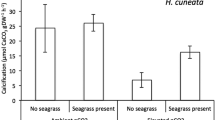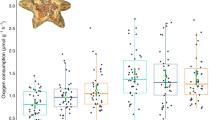Abstract
The Arctic Ocean currently has the highest global average pH. However, due to increasing atmospheric CO2 levels, it will become a region with one of the lowest global pH levels. In addition, Arctic waters will also increase in temperature as a result of global warming. These environmental changes can pose a significant threat for marine species, and in particular true Arctic species that are adapted to the historically cold and relatively stable abiotic conditions of the region. Consequently, we investigated some key physiological responses of brittlestar Ophiocten sericeum, a polar endemic which can dominate benthic infauna, to a temperature increase of 3.5°C (ambient, 5–8.5°C) and CO2 induced reduction in pH of 0.6 units (pH 7.7) and 1 unit (pH 7.3) below ambient (pH 8.3). Metabolism was upregulated at low pH. Faster arm regeneration stimulated by increased temperature was counteracted by low pH; at pH 7.3 in the high-temperature treatment, the maintenance of calcium carbonate structures in undersaturated conditions resulted in reduction in the rate of arm regeneration, possibly due to accelerated the use of energy reserves. If so, this could result in an energy deficit at times of increased energetic costs associated with responding to the combined factors of high temperature and low pH.





Similar content being viewed by others
References
Anderson MJ (2001) A new method for non-parametric multivariate analysis of variance. Aust Ecol 26:32–46
Anderson MJ, Gorley RN, Clarke KR (2008) PERMANOVA+ for PRIMER: guide to software and statistical methods PRIMER-E. Plymouth
Andersson AJ, Mackenzie FT, Bates NR (2008) Life on the margin: implications of ocean acidification on Mg-calcite, high latitude and cold water marine calcifiers. Mar Ecol Prog Ser 373:265–273. doi:10.3354/meps07639
Checkley DM, Dickson AG, Takahashi M, Radich JA, Eisenkolb N, Asch R (2009) Elevated CO2 enhances otolith growth in young fish. Science 324:1683. doi:10.1126/science.1169806
Clark D, Lamare M, Barker M (2009) Response of sea urchin pluteus larvae (Echinodermata: Echinoidea) to reduced seawater pH: a comparison among a tropical, temperate, and a polar species. Mar Biol 156:1125–1137. doi:10.1007/s00227-009-1155-8
Comeau S, Gorsky G, Jeffree R, Teyssié J-L, Gattuso J-P (2009) Key Arctic pelagic mollusc (Limacina helicina) threatened by ocean acidification. Biogeosci Discuss 6:2523–2537. doi:10.5194/bg-6-1877-2009
Dashfield SL, Somerfield PJ, Widdicombe S, Austen MC, Nimmo M (2008) Impacts of ocean acidification and burrowing urchins on within sediment pH profiles and subtidal nematode communities. J Exp Mar Biol Ecol 365:46–52. doi:10.1016/j.jembe.2008.07.039
Dickson AG (1990) Standard potential of the reaction—AgCl(S) + 1/2H–2(g) = AG(S) + HCL(aq) and the standard acidity constant of the ion HSO4- in synthetic sea-water from 27315-K to 31815-K. J Chem Thermodyn 22:113–127. doi:10.1016/0021-9614(90)90074-Z
Dickson AG, Millero FJ (1987) Comparison of the equilibrium-constants for the dissociation of carbonic-acid in seawater media. Deep Sea Res 34:1733–1743. doi:10.1016/0198-0149(87)90021-5
Dupont S, Thorndyke MC (2006) Growth or differentiation? Adaptive regeneration in the brittlestar Amphiura filiformis. J Exp Biol 209:3873–3881. doi:10.1242/jeb.02445
Gage JD, Tyler PA (1993) Deep-sea biology: a natural history of organisms at the deep-sea floor. Cambridge University Press, Cambridge
Hauton C, Tyrrell T, Williams J (2009) The subtle effects of sea water acidification on the amphipod Gammarus locusta. Biogeosci Discus 6:919–946. doi:10.5194/bgd-6-919-2009
Hu YY, Pan LF (2009) Arctic stratospheric winter warming forced by observed SSTs. Geophys Res Lett 36:L11707. doi:10.1029/2009GL037832
Kurihara H, Shirayama Y (2004) Effects of increased atmospheric CO2 on sea urchin early development. Mar Ecol Prog Ser 274:161–169. doi:10.3354/meps274161
Langer G, Geisen M, Baumann KH, Klas J, Riebesell U, Thoms S, Young JR (2006) Species-specific responses of calcifying algae to changing seawater carbonate chemistry. Geochem Geophys Geosyst 7:Q09006. doi:10.1029/2005GC001227
McArdle BH, Anderson MJ (2001) Fitting multivariate models to community data: a comment on distance-based redundancy analysis. Ecology 82:290–297. doi:10.1890/0012-9658(2001)082[0290:FMMTCD]2.0.CO;2
MCCIP (Marine Climate Change Impacts Partner) (2008) Marine climate change impacts Annual Report Card 2007–2008 http://wwwmcciporguk/arc/2007/
McDonald MR, McClintock JB, Amsler CD, Rittschof D, Angus RA, Orihuela B, Lutostanski K (2009) Effect of ocean acidification over the life history of the barnacle Amphibalanus Amphitrite. Mar Ecol Prog Ser 385:179–187. doi:10.3354/meps08099
McNeil BI, Matear RJ (2007) Climate change feedbacks on future oceanic acidification. Tellus B 59:191–198. doi:10.1111/j.1600-0889.2006.00241.x
Mehrbach C, Culberson CH, Hawley JE, Pytkowicz RM (1973) Measurement of the apparent dissociation constants of carbonic acid in seawater at atmospheric pressure. Limnol Oceanogr 18:897–907. doi:10.4319/lo.1973.18.6.0897
Mieszkowska N, Leaper R, Moore P et al (2005) Marine biodiversity and climate change: assessing and predicting the influence of climatic change using intertidal rocky shore biota. Occasional Publication Marine Biological Association of the United Kingdom, 20 Marine Biological Association of the United Kingdom. Plymouth, UK
Miles H, Widdicombe S, Spicer JI, Hall-Spencer J (2007) Effects of anthropogenic seawater acidification on acid-base balance in the sea urchin Psammechinus miliaris. Mar Pollut Bull 54:89–96. doi:10.4319/lo.1973.18.6.0897
Pane EF, Barry JP (2007) Extracellular acid–base regulation during short-term hypercapnia is effective in a shallow-water crab, but ineffective in a deep-sea crab. Mar Ecol Prog Ser 334:1–9. doi:10.3354/meps334001
Paterson GLJ, Tyler PA, Gage JD (1982) The taxonomy and zoogeography of the genus Ophiocten (Echinodermata:Ophiuroidea) in the North Atlantic Ocean. Bull Br Mus Nat Hist (D Zool) 43:109–128
Piepenburg D, Schmid MK (1996) Brittle star fauna (Echinodermata: Ophiuroidea) of the arctic northwestern Barents Sea: composition, abundance, biomass and spatial distribution. Polar Biol 16:383–392. doi:10.1007/BF02390420
Piepenburg D, Chernova NV, von Dorrien CF, Gutt J, Neyelov AV, Rachor E, Saldanha L, Schmid MK (1996) Megabenthic communities in the waters around Svalbard. Polar Biol 16:431–446. doi:10.1007/BF02390425
Piepenburg D, Voss J, Gutt J (1997) Assemblages of sea stars (Echinodermata: Asteroidea) and brittle stars (Echinodermata: Ophiuroidea) in the Weddell Sea (Antarctica) and off Northeast Greenland (Arctic): a comparison of diversity and abundance. Polar Biol 17:305–322. doi:10.1007/PL00013372
Pierrot D, Lewis E, Wallace DWR (2006) Co2sys dos program developed for CO2 system calculations ORNL/CDIAC-105 carbon dioxide information analysis center, Oak Ridge National Laboratory. US Department of Energy, Oak Ridge
Pörtner HO, Knust R (2007) Climate change affects marine fishes through the oxygen limitation of thermal tolerance. Science 315:95–97. doi:10.1126/science.1135471
Pörtner HO, Peck L, Somero G (2007) Thermal limits and adaptation in marine Antarctic ectotherms:an integrative view. Phil Trans Roy Soc Lond B 362:2233–2258. doi:10.1098/rstb.2006.1947
Raven J, Caldeira K, Elderfield H, Hoegh-Guldberg O, Liss P, Riebesell U, Sheperd J, Turley C, Watson A (2005) Ocean acidification due to increasing atmospheric carbon dioxide. The Royal Society policy document 12/05, Clyvedon Press, Cardiff
Shirayama Y, Thornton H (2005) Effect of increased atmospheric CO2 on shallow water marine benthos. J Geophys Res 110:C09S08. doi:10.1029/2004JC002618
Smith WO, Marra J, Hiscock MR, Barber RT (2000) The seasonal cycle of phytoplankton biomass and primary productivity in the Ross Sea, Antarctica. Deep-Sea Res Pt II-Top Studies Oceanogr 47:3119–3140. doi:10.1016/S0967-0645(00)00061-8
Spicer JI, Eriksson SP (2003) Does the development of respiratory regulation always accompany the transition from pelagic larvae to benthic fossorial postlarvae in the Norway lobster Nephrops norvegicus (L)? J Exp Mar Biol Ecol 295:219–243. doi:10.1016/S0022-0981(03)00296-X
Steinacher M, Joos F, Frőlicher TL, Plattner G-K, Doney SC (2009) Imminent ocean acidification in the Arctic projected with the NCAR global coupled carbon cycle-climate model. Biogeo-Sciences 6:515–533. doi:10.5194/bg-6-515-2009
Thorndyke MC, Patruno M, Dewael Y, Dupont S, Mallefet J (2003) Regeneration in the ophiuroid Amphiura filiformis: cell biology, physiology and luminescence. In: Féral J-P, David B (eds) Echinoderm research 2001: proceedings of the 6th European conference on echinoderm research, Banyuls-sur-mer, 3–7 Sep 2001, pp 193–199
Walther K, Sartoris FJ, Bock C, Pörtner HO (2009) Impact of anthropogenic ocean acidification on thermal tolerance of the spider crab Hyas araneus. Biogeosci Discuss 6:2837–2861. doi:10.5194/bgd-6-2837-2009
Wlodarska-Kowalczuk M, Kendall MA, Weslawski JM, Klages M, Soltwedel T (2004) Benthic diversity and biomass along the continental margin at a high latitude ice-free site (off West Spitsbergen, 79°N). Deep Sea Res 51:1903–1914. doi:10.1016/j.dsr.2004.07.013
Wood HL, Spicer JI, Widdicombe S (2008) Ocean acidification may increase calcification, but at a cost. Proc Roy Soc Lond B 275:1767–1773. doi:10.1098/rspb.2008.0343
Wood HL, Spicer JI, Lowe DM, Widdicombe S (2010) Interaction of ocean acidification and temperature; the high cost of survival in the brittlestar Ophiura ophiura. Mar Biol 157:2001–2013. doi:10.1007/s00227-010-1469-6
Wright A, Wadham J, Siegert M, Luckman A, Kohler J (2006) Modelling the impact of superimposed ice on the mass balance of an Arctic glacier under scenarios of future climate change. Annals Glaciol 42:277–283. doi:10.3189/172756405781813104
Acknowledgments
The authors thank Dr Jozef Wiktor and the crew aboard RV Oceania for their assistance in animal collection, Elin Austerheim for technical assistance and Helen Findlay for assistance in the laboratory. This work was supported by an ARCFAC grant awarded to HSF & HLW and a NERC Blueskies PhD studentship awarded to HLW. This work is a contribution to PML Theme 3 within the NERC funded programme Oceans 2025. Thanks to Chris Hauton and two anonymous referees whose comments on a previous version of this manuscript were of invaluable help in improving this work.
Author information
Authors and Affiliations
Corresponding author
Rights and permissions
About this article
Cite this article
Wood, H.L., Spicer, J.I., Kendall, M.A. et al. Ocean warming and acidification; implications for the Arctic brittlestar Ophiocten sericeum . Polar Biol 34, 1033–1044 (2011). https://doi.org/10.1007/s00300-011-0963-8
Received:
Revised:
Accepted:
Published:
Issue Date:
DOI: https://doi.org/10.1007/s00300-011-0963-8




